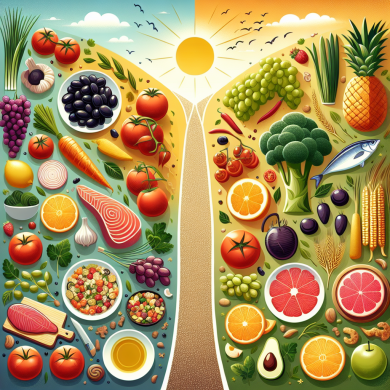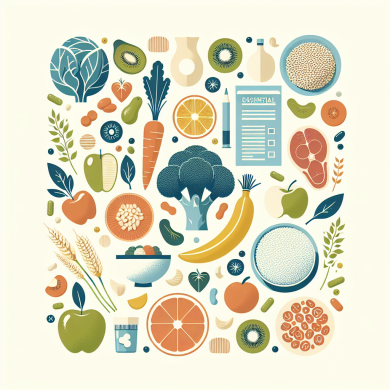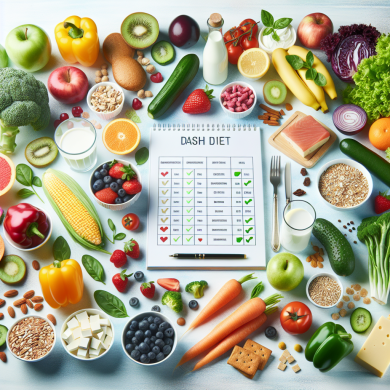Boost Heart Health with DASH Diet Essentials
Introduction
Heart disease remains a leading cause of death worldwide, prompting a growing interest in dietary interventions for cardiovascular health. Among the most researched and recommended dietary patterns is the DASH diet, which stands for Dietary Approaches to Stop Hypertension. This eating plan was initially developed to address high blood pressure, but its benefits extend far beyond hypertension, offering a comprehensive approach to heart health. In this article, we will explore the essentials of the DASH diet and how it can be a powerful tool in boosting heart health.
Understanding the DASH Diet
The DASH diet emphasizes a balanced intake of nutrients that are crucial for maintaining heart health. It is characterized by high consumption of fruits, vegetables, whole grains, lean proteins, and low-fat dairy, while limiting foods high in saturated fats, cholesterol, and sodium. The primary goal is to reduce blood pressure, but the diet also helps in managing cholesterol levels and promoting overall cardiovascular wellness.
The Core Principles of the DASH Diet
Fruits and Vegetables
Fruits and vegetables are rich in vitamins, minerals, and fiber, all of which are vital for heart health. They provide antioxidants that help combat oxidative stress, reduce inflammation, and lower blood pressure. The DASH diet recommends consuming 4-5 servings of each per day.
Whole Grains
Whole grains such as brown rice, quinoa, and whole wheat bread are preferred over refined grains. They are excellent sources of fiber, which aids in lowering cholesterol and maintaining healthy blood pressure levels. The diet suggests 6-8 servings of grains daily, with an emphasis on whole grains.
Lean Proteins
Proteins are essential for muscle repair and overall health, but the type of protein matters. The DASH diet encourages consumption of lean proteins such as poultry, fish, and legumes. Fish, in particular, provides omega-3 fatty acids, which have been shown to reduce triglyceride levels and support heart health. Aim for 2 or fewer servings of lean protein per day.
Low-Fat Dairy
Dairy products are a good source of calcium and vitamin D, both important for cardiovascular and bone health. The DASH diet recommends choosing low-fat or non-fat options to minimize saturated fat intake. Include 2-3 servings of dairy in your daily diet.
Nuts, Seeds, and Legumes
These foods are excellent sources of healthy fats, protein, and fiber. They help in reducing cholesterol levels and maintaining arterial health. Consuming 4-5 servings per week is recommended in the DASH diet.
Reducing Sodium Intake
One of the key objectives of the DASH diet is to significantly reduce sodium intake, which is directly linked to blood pressure levels. The standard recommendation is to consume no more than 2,300 mg of sodium per day, with an ideal target of 1,500 mg for those with hypertension. This involves avoiding processed foods, reading food labels carefully, and opting for herbs and spices to flavor meals instead of salt.
Beneficial Effects on Heart Health
Lowering Blood Pressure
High blood pressure is a major risk factor for cardiovascular disease. Studies have consistently shown that the DASH diet is effective in lowering blood pressure in individuals with hypertension. This effect is attributed to the diet’s emphasis on potassium-rich foods, reduced sodium intake, and balanced nutrient profile.
Improving Lipid Profile
The DASH diet helps in improving lipid profiles by lowering LDL (bad) cholesterol and maintaining healthy HDL (good) cholesterol levels. This is achieved through its focus on healthy fats and high-fiber foods, which play a crucial role in managing cholesterol levels.
Weight Management
Maintaining a healthy weight is vital for heart health, and the DASH diet supports weight management through its balanced and nutrient-dense food choices. By reducing calorie-dense, nutrient-poor foods, it helps in achieving and maintaining a healthy weight, further reducing the risk of heart disease.
Practical Tips for Implementing the DASH Diet
Plan Your Meals
Planning meals ahead of time can help ensure that you are meeting the DASH diet guidelines. Incorporate a variety of fruits, vegetables, and whole grains into your meals and experiment with different recipes to keep your diet interesting.
Read Food Labels
Understanding food labels is crucial for managing sodium intake. Look for low-sodium options and be aware of hidden sodium in processed and packaged foods.
Cook at Home
Preparing meals at home allows you to control ingredients and portion sizes. Use herbs, spices, and citrus to enhance flavors without adding salt.
Gradual Changes
Transitioning to the DASH diet can be easier by making gradual changes. Start by incorporating more fruits and vegetables into your diet, then slowly reduce sodium and increase whole grain intake.
Conclusion
The DASH diet is a well-rounded, sustainable approach to improving heart health and preventing cardiovascular disease. By focusing on nutrient-rich foods and reducing sodium intake, it offers multiple benefits that extend beyond blood pressure management. Incorporating the DASH diet essentials into your lifestyle can lead to a healthier heart and a longer, more vibrant life.















Add comment